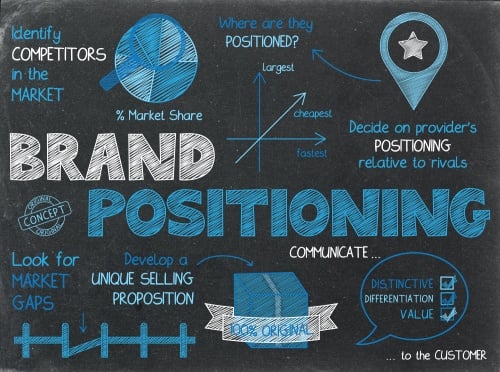
Because financial institutions are known for offering a similar range of services, customers typically have little, if any, point of differentiation when choosing whom to give their business to, begging the questions:
Why should your customers choose you? What makes you different?
One of the primary criterion that drives all successful brands is the ability to deliver something relevant to consumers on a consistent basis. Then, hopefully, the strategy employed isn’t something competitors can easily replicate—it's difficult to duplicate. The more your brand meets these criteria, the more successful you will be.
Of all the components fueling a strong brand, the most critical is differentiation. Historically, financial services (FinServ) institutions preached that “price was the only thing driving consumer decisions” and that “big banks get business because they have branches on every corner.”
As a result, they commoditized themselves with rates, fees, and locations being the only tangible, relevant points of differentiation that most FinServ companies offered consumers. When financial institutions look, sound, and act alike, consumers dwell on whatever differences they can find. That means when it comes to making decisions, rates, fees, and locations will be the deciding factors.
Better Brand Positioning in a Crowded Marketplace
The need to stand out from the competition is vital, but more importantly, to win, financial institutions need to examine existing challenges that may be preventing them from achieving true differentiation in their industry.
Over the years, the traditional perceptions of financial services have changed significantly, giving the industry a broader scope to redefine how they want to be perceived by consumers. Many FinServ companies are trying to be everything to everyone which runs the risk of being indistinguishable from everyone else in the industry.
FinServ brands need to take a proactive approach to stand out in the market and avoid commoditization. It means verifying their competitive advantage and positioning themselves in consumers’ minds so that the brand promise meets the needs of their target market.
Differentiation Creates a Competitive Positioning Hard to Beat
Rather than compete with the well-known and recognized key players in the industry, many successful FinServ brands understand that identifying what makes them unique and using that to drive their message to the market, is the key to getting and retaining people’s business.
The Simple Strategy—Easy Banking
The all-electronic consumer banking app, Simple, didn’t want to compete with the biggest banks out there because they knew they couldn’t. Simple found a way to work with their model so they can continue to be who they have always been: a simple no-frills approach bank where customers can easily and securely complete financial transactions.
Simple did, however, want to be known as a bank that offers a better, more convenient, and personalized way for customers to complete their transactions. With this as their differentiator and competitive advantage, they were able to create a unique brand identity that distinctly sets them apart from everyone else. If you want convenient, fast banking, Simple is your brand.
How to Win with Customers
Customer experience (CX) has become the newest battleground for customer retention. Since financial services is a relationship-based industry, the CX is the top contributing factor to successful and long-term relationships that drive business performance. Unlike locations, branches, and products, CX—voice of the customer, customer segmentation, consumer personas, customer journey mapping, and even changes to the business model—is one of very few factors that heavily influence customer acquisition and retention, and can't be easily replicated.
Research has shown that high-potential organizations fast-track their growth by having a strong differentiator. Simple achieved this by taking the customer-centric approach a step further and using technology to improve customer-facing services such (e.g., mobile banking apps), so everyday bank transactions can be done online and on the go.
The new consumer-driven business strategies will initially distinguish leaders from followers; leaders who take a wait and see approach are risking more innovative competitors will make them irrelevant. For example, Forrester predicts the average number of channels people will use regularly will increase from 9 to 11. Employees need to be able to communicate over these new channels and seamlessly communicate across them. Using business intelligence to acquire new customers while, at the same time, doubling down on customer strategies (e.g., omni-channel CX management) will solidify existing relationships and help retain those customers.
How to Win with the Brand
Many financial services brands are already looking for the best brand positioning for their business to manage how they are perceived in the minds of customers, prospects, and other relevant stakeholders. Brands are most valuable with sophisticated financial services products. For solutions that are difficult to understand, consumers turn to credibility and consider trust and confidence inspired by the brand as a source of risk reduction. So, what is missing?
In a time where customer trust is wavering, there’s an opportunity for financial services to achieve true differentiation by making sure they deliver what they promise and regain the confidence of their audience. However, it has to be more than just finding that one unique attribute that makes you stand out; it also lies heavily on how distinctly you follow through on your brand message to regain customers’ trust.
Take a Closer Look at Messaging
Financial fraud and cybercrime are breaking financial institutions, and they are failing to deliver quality service and risk mitigation. Fintech firms, popping up everywhere, promise security but lack the legitimacy to back it. However, they are focusing their marketing tactics primarily on their technology — without any consideration of what this means for customers. As a result, while technologically they might be legitimate and trustworthy, their customers do not necessarily agree.
A better way to approach perceived legitimacy is by selling the implications of the technology rather than the technology itself. Your brand messaging refers to the underlying value proposition conveyed and language used in your content. It's what makes buyers relate to your brand by inspiring them, persuading them, motivating them, and ultimately making them want to buy your service. Re-examine everything that defines your brand. Ask yourself if it consistently represents the same message to which you want your customers to respond.
Customers want first to know what it means for them, and only then do they care about the technology. With powerful and clear brand messaging as a guide, not only do you stand out, you ensure your audience finds value in the services you offer so they know you are the best company to turn to for their specific need.
ClearScore: ‘Just Free. Forever’
Launched in 2015, ClearScore is a UK credit-checking company that is synonymous with clarity and great user experience (UX). Using language that empowers— ‘your credit score should be free’— it powerfully declares ‘Just free. Forever’.
Aiming to appeal to a new set of younger and more digitally savvy consumers, ClearScore based many of its interactions around an app—iPhone/iPad, Apple Watch, and Android— and provides its credit score updates and financial ‘health check’ in real time and free of charge. ClearScore is true to its name with a website that appears to exist only to provide consumers their credit score, which is precisely what they want. In doing so, they gave their customers a sense of control using a powerful branding strategy.
Being transparent with data, spam, and risk-free credit score checking is vital to the brand. These standards are essential to consumers who don’t want their score or their personal information to be compromised just because they are seeking information to improve their situation.
ClearSource’s value proposition has had a significant effect on the competition. So much so that competitor, Experian, who also offers a credit score which it then uses it to suggest financial products, announced that it is acquiring ClearScore later this year.
Differentiation—The Key to Staying Ahead
In financial services, or any other industry, gone are the days when everything was dominated by major market players who stood out because of longevity and having specialized services. Adapting to the changing times means FinServ companies must transition to a customer-centric business model—while staying true to their brand promise—to differentiate from their competitors, better serve the needs of their customers, and win in consumers’ minds.
Does your business have a differentiator? Let experienced brand consultants help you find it. Get in touch with us.
Recent Posts
Posts by Topics
- Brand Strategy (57)
- Brand Strategy Consulting (28)
- Brand Differentiation (27)
- Customer Experience (24)
- Brand Positioning (22)
- Marketing Strategy (9)
- Brand Extension Strategy (8)
- Customer Behavior (8)
- Brand Architecture Strategy (7)
- Brand Extension (7)
- Brand Growth (7)
- Brand Portfolio & Architecture (7)
- Brand Purpose (7)
- Brand Value Proposition (7)
- Brand Engagement (6)
- Brand Portfolio Strategy (6)
- Brand Storytelling (6)
- Rebranding Strategy (6)
- Brand Awareness (5)
- Brand Image (5)
- Branding (5)
- Rebranding (5)
- Technology (5)
- B2B Brand Strategy (4)
- Brand Experience (4)
- Value Proposition (4)
- Brand Extendibility (3)
- Brand Metrics (3)
- Brand Repositioning (3)
- Corporate Branding (3)
- Differentiation Strategy (3)
- Measurement & Metrics (3)
- Brand Engagement Strategy (2)
- Brand Portfolio (2)
- Brand Promise (2)
- Brand Voice (2)
- Digital Marketing (2)
- Digital and Brand Experience (2)
- Employee Brand Engagement (2)
- Brand Architecture (1)
- Brand Development (1)
- Brand Equity (1)
- Brand Identity (1)
- Brand Measurement (1)
- Brand Name (1)
- Brand Strategy Consultants (1)
- Brand Strategy Firms (1)
- Digital Strategy (1)
- Internal Branding (1)
- Messaging (1)

